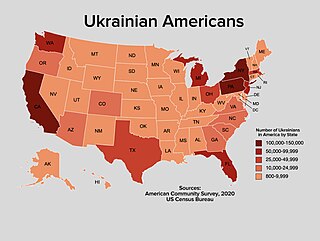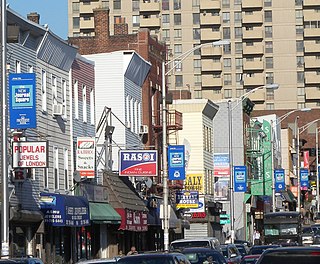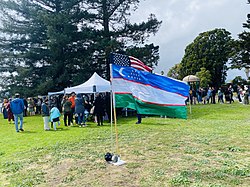
Demographic features of the population of Uzbekistan include population growth, population density, ethnicity, education level, health, economic status, religious affiliations, and other aspects of the population. The nationality of a person from Uzbekistan is Uzbekistani, while the ethnic Uzbek majority call themselves Uzbeks. Much of the data is estimated because the last census was carried out in Soviet times in 1989.

Romanian Americans are Americans who have Romanian ancestry. According to the 2017 American Community Survey, 478,278 Americans indicated Romanian as their first or second ancestry, however other sources provide higher estimates, which are most likely more accurate, for the numbers of Romanian Americans in the contemporary United States; for example, the Romanian-American Network supplies a rough estimate of 1.2 million who are fully or partially of Romanian ethnicity. There is also a significant number of people of Romanian Jewish ancestry, estimated at about 225,000.

New York City is a large and ethnically diverse metropolis. It is the largest city in the United States with a long history of international immigration. The New York region continues to be by far the leading metropolitan gateway for legal immigrants admitted into the United States. The city is the geographical and demographic center of both the Northeast megalopolis and the New York metropolitan area, the largest metropolitan area in the U.S. by both population and urban area. With over 20.1 million people in its metropolitan statistical area and 23.5 million in its combined statistical area as of 2020, New York City is one of the world's most populous megacities.
Egyptian Americans are Americans of partial or full Egyptian ancestry. The 2016 US Census estimated the number of people with Egyptian ancestry at 256,000, most of whom are from Egypt's Christian Orthodox Coptic minority. Egyptian Americans may also include the Egyptian foreign-born population in the United States. The US Census Bureau estimated in 2016 that there were 181,677 foreign-born Egyptians in the United States. They represented around 0.4% of the total US foreign-born population as 42,194,354 first-generation immigrants in 2016. Egyptians are concentrated in New York City and Los Angeles. California has the largest Egyptian population by state.

Bangladeshi Americans are Americans of Bangladeshi descent. Most Bangladeshi Americans are also Bengali Americans. Bangladeshi Americans are usually Muslims with roots in Bangladesh in which Bengali is the majority language. Since the early 1970s, Bangladeshi immigrants have arrived in significant numbers to become one of the fastest growing ethnic groups in the U.S. New York City is home to two-thirds of the Bangladeshi American population. Meanwhile, Paterson, New Jersey; Atlantic City, New Jersey; and Monroe Township, Middlesex County, New Jersey also home to notable Bangladeshi communities. Over 400,000 people leave Bangladesh with the sole goal of finding employment in other countries.
Sri Lankan Americans are Americans of full or partial Sri Lankan ancestry. Sri Lankan Americans are persons of Sri Lankan origin from various Sri Lankan ethnic backgrounds. The people are classified as South Asian in origin.

Malaysian Americans are Americans of Malaysian ancestry. Rather than a single ethnic group, Malaysian Americans descend from a variety of ethnic groups that inhabit the Southeast Asian country of Malaysia, all of which speak different languages and profess different cultures and beliefs, including Malay, Chinese and Tamil, as Malaysian is primarily a national identification. According to answers provided to an open-ended question included in the 2019 US Census, 38,227 people said that their ancestry or ethnic origin was Malaysian.

Mass migration refers to the migration of large groups of people from one geographical area to another. Mass migration is distinguished from individual or small-scale migration; and also from seasonal migration, which may occur on a regular basis.

Ukrainian Americans are Americans who are of Ukrainian ancestry. According to U.S. census estimates, in 2021 there were 1,017,586 Americans of Ukrainian descent representing 0.3% of the American population. The Ukrainian population of the United States is thus the second largest outside the former Eastern Bloc; only Canada has a larger Ukrainian community under this definition. According to the 2000 U.S. census, the metropolitan areas with the largest numbers of Ukrainian Americans are: New York City with 160,000; Philadelphia with 60,000; Chicago with 46,000; Detroit with 45,000; Los Angeles with 36,000; Cleveland with 26,000; Sacramento with 20,000; and Indianapolis with 19,000. In 2018, the number of Ukrainian Americans surpassed 1 million.

India Square, also known as "Little India," is a commercial and restaurant district in the Journal Square and Marion Section neighborhoods of Jersey City, New Jersey, US.

According to the U.S. Census Bureau, as of 2023, New York was the fourth largest state in population after California, Texas, and Florida, with a population of 19,571,216, a decrease of over 600,000 people, or −3.1%, since the 2020 census. The population change between 2000–2006 includes a natural increase of 601,779 people and a decrease due to net migration of 422,481 people out of the state. Immigration from outside the United States resulted in a net increase of 820,388 people, and migration within the country produced a net loss of about 800,213.
Azerbaijani Americans are Americans of the Azerbaijani ancestry from the Republic of Azerbaijan and Iranian Azerbaijan or people possessing Azerbaijani, Iranian, and/or American citizenship. Most Azerbaijani Americans have immigrated to the United States from Azerbaijan, Iran, Germany, Georgia, Russia, Turkey and Ukraine.
Georgian Americans are Americans of full or partial Georgian ancestry. They encompass ethnic Georgians who have immigrated to the U.S. from Georgia, as well as other areas with significant Georgian populations, such as Russia.
Israeli Americans are Americans who are of full or partial Israeli descent. In this category are those who are Israelis through nationality and/or citizenship. Reflecting Israel's demographics, while the vast majority of the Israeli American populace is Jewish, it is also made up of various ethnic and religious minorities; most notably the ethnic Arab minority, which includes Muslims, Christians, and the Druze, as well as the smaller non-Arab minority ethnic groups.
The Office of Immigration Statistics (OIS) is an agency of the United States Department of Homeland Security under the Office of Strategy, Policy, and Plans.

New York City is home to the largest Russian or Russophone population in the Western Hemisphere. The largest Russian-American communities in New York City are located in Brighton Beach and Sheepshead Bay in Brooklyn. Brighton Beach has been nicknamed Little Odessa due to its population of Russian-speaking immigrants from the Former Soviet Union.
Coptic Americans are American citizens of Coptic descent or persons of Coptic descent residing in the United States. As of 2018, there were some 500,000 Copts living in the United States.

Gujarati Americans are Americans who trace their ancestry to Gujarat, India. They are a subgroup of Indian Americans.














